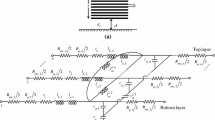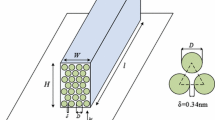Abstract
In this paper a time-domain response and Nyquist stability criterion to acquire dependence of degree of crosstalk relative stability based on transmission lines modeling (TLM) is investigated for coupled multilayer graphene nanoribbon (MLGNR) interconnects. This is the first instance that such an analysis has been presented for coupled MLGNR consisting of both capacitive and mutual-inductive couplings. The near-end and far-end outputs of coupled MLGNR individually are compared in two cases, with considering both couplings and without them (single MLGNR). It is observed that the near-end output of the system together with both couplings is more stable and at its far-end output, an induced voltage is created. By increasing capacitive coupling or decreasing inductive coupling, the near-end output becomes more stable. Also, the results of changes of length and width of each ribbon show that by increasing the length and decreasing the width, the coupled MLGNR interconnects become more stable.







Similar content being viewed by others
References
H. Aghababa, N. Masoumi, Time-domain analysis of carbon nanotubes, in Proceedings of the 7th Int. Caribbean Conference on Devices, Circuits System (ICCDCS), 28–30 April (IEEE Press, Cancun, 2008), pp. 1–4
P. Chandrasekhar, R. Rao, Computationally efficient analytical crosstalk noise model in RC interconnects. Int. J. Math. Models Methods Appl. Sci. 1(2), 35–45 (2007)
P. Chandrasekhar, R. Rao, An accurate analytical crosstalk model for RC interconnect, in Proceedings of the 2nd WSEAS International Conference on Circuits, Systems, Signal and Telecommunication (CISST’08), January (2008), pp. 29–35
M.H. Chowdhury, Y.I. Ismail, Behavior and analysis of deep sub-micron integrated behavior and analysis of deep sub-micron integrated. Circuits Syst. Signal Process. 27(1), 22–34 (2008)
D. Das, H. Rahaman, Crosstalk analysis in carbon nanotube interconnects and its impact on gate oxide reliability, in Proceedings of the 2nd Asian Symposium on Quality Electronic Design (ASQED), 3–4 August (IEEE Press, Penang, 2010), pp. 272–279
D. Das, H. Rahaman, Crosstalk and gate oxide reliability analysis in graphene nanoribbon interconnects, in Proceedings of the 2011 International Symposium on Electronic System Design (ISED), 19–21 December (IEEE Press, Kochi, 2011), pp. 182–187
A. Deutsch et al., The importance of inductance and inductive coupling for on-chip wiring, in Proceedings of the 6th IEEE Topical Meeting on Electrical Performance Electrical Packaging, 27–29 October (1997), pp. 53–56
R.C. Dorf, R.H. Bishop, Modern Control System (Prentice Hall, Englewood, 2008)
L. Egiziano, A. Giustiniant, G. Pinelli, V. Tucci, W. Zamboi, Crosstalk modeling and analysis of interconnects based on carbon nanotube bundles, in Proceedings of the14th IEEE Workshop on Signal Propagation on Interconnects (SPI), 9–12 May (2010), pp. 145–148
D. Fathi, B. Forouzandeh, S. Mohajerzadeh, R. Sarvari, Accurate analysis of carbon nanotube interconnects using transmission line model. IET Micro Nano Lett. 4(2), 116–121 (2009)
A. Lopez, D. Deschacht, Illustration of the importance of on-chip self and mutual inductances, in Proceedings of the 8th IEEE Workshop on Signal Propagation on Interconnects, 9–12 May (2004), pp. 113–116
A. Naeemi, J. Meindl, Compact physics-based circuit models for graphene nanoribbon interconnects. IEEE Trans. Electron Devices 56(9), 1822–1833 (2009)
S.H. Nasiri, M.K. Moravvej-Farshi, R. Faez, Stability analysis in graphene nanoribbon interconnects. IEEE Electron Device Lett. 31, 1458–1460 (2010)
H. Parashar, G. Singh, Effects of capacitive and inductive coupling on interconnects at RF frequencies, in Proceedings of the 2011 International Conference on Devices and Communications (ICDeCom), 24–25 February (IEEE Press, Mesra, 2011), pp. 1–5
S.N. Pu, W.Y. Yin, J.F. Mao, Q.H. Liu, Crosstalk Predication of Single- and Double-Walled Carbon-Nanotube (SWCNT/DWCNT) bundle interconnects. IEEE Trans. Electron Devices 56(4), 560–568 (2009)
D. Rossi, J.M. Cazeaux, C. Merta, F. Lombardi, Modeling crosstalk effects in CNT bus architectures. IEEE Trans. Nanotechnol. 6(2), 133–145 (2007)
T. Sakurai, Closed-form expressions for interconnect delay, coupling, and crosstalk in VLSIs. IEEE Trans. Electron Devices 40, 118–124 (1993)
H. Shaikhassadi, N. Masoumi, A. Hakimi, Crosstalk modeling in multiwalled carbon nanotubes as interconnects using the compact RC model, in Proceedings of the 15th IEEE Workshop on Signal Propagation on Interconnects (SPI), 8–11 May (2011), pp. 133–136
Q. Shao, G. Liu, D. Teweldebrhan, A.A. Balandin, High-temperature quenching of electrical resistance in graphene interconnects. Appl. Phys. Lett. 92(20), 202108 (2008)
D.K. Sharmsa, B.K. Kushik, R.K. Sharmsa, A qualitative approach to optimize coupling capacitance for simultaneously switching scenario in coupled VLSI interconnects, in Proceedings of the 2011 International Conference on Devices and Communications (ICDeCom), 24–25 February (IEEE Press, Mesra, 2011), pp. 1–5
S. Tanachutiwat, W. Wang, Exploring multi-layer graphene nanoribbon interconnects, in Institute for Computer Sciences, Social Informatics and Telecommunications Engineering, vol. 3, (2009), pp. 49–53
H. Wang, J. Song, F. Liu, H. Xiang, W. Gao, L. Wan, Crosstalk analysis and optimization of high-speed interconnects, in Proceedings of the 12th International Conference on Electronic Packaging Technology and High Density Packaging (ICEPT-HDP), 8–11 August (IEEE Press, Shanghai, 2011), pp. 1–4
C. Xu, H. Li, K. Banerji, Modeling, analysis, and design of graphene nano-ribbon interconnects. IEEE Trans. Electron Devices 56(8), 1567–1578 (2009)
W. Zhu, V. Perebeinos, M. Freitag, P. Avouris, Carrier scattering, mobility and electrostatic potential in monolayer, bilayer, and trilayer graphene. Phys. Rev. B, Condens. Matter 80(23), 2354021 (2009)
2009 International Technology Roadmap for Semiconductors (2009 ITRS). http://www.itrs.net
Author information
Authors and Affiliations
Corresponding author
Rights and permissions
About this article
Cite this article
Akbari, L., Faez, R. Crosstalk Stability Analysis in Multilayer Graphene Nanoribbon Interconnects. Circuits Syst Signal Process 32, 2653–2666 (2013). https://doi.org/10.1007/s00034-013-9606-3
Received:
Revised:
Published:
Issue Date:
DOI: https://doi.org/10.1007/s00034-013-9606-3




